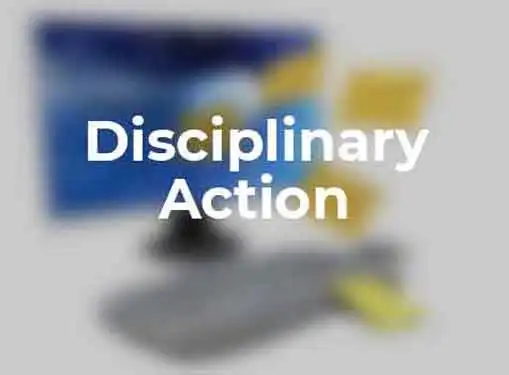Managing Employees
Disciplinary Action Form
Employee discipline is never an easy process. But there's only one way to document the event, protect your business and establish a foundation for improvement - and that's with a disciplinary action form.
Sooner or later, one of your employees is going to violate a company policy.

Hopefully, the infraction isn't too severe. But whether it's severe or not, policy violations need to be addressed. If they are allowed to persist, relatively minor policy infractions will quickly escalate into bigger problems or a hostile work environment.
The consequences for violating company policies should be clearly described in your employee handbook and discipline policies. But as a precursor to policy enforcement, specific events should be properly investigated and discussed with the employee.
Disciplinary action forms are used to document specific events that violate company policies or workplace standards. In many cases, a disciplinary action form and meeting with the employee is sufficient to meet the disciplinary procedures described in the employee handbook. If further steps are required, the disciplinary action form initiates the process. To get you started, here are a few of the issues your company's disciplinary action form should address.
- Description of incident. After you've identified the name of the employee and supervisor, the disciplinary action form has ample space dedicated to a description of the event. Details like names, dates and times are important in case the story needs to be corroborated or the incident is part of a sequence of events.
- Identification of policy violated. One of the benefits of using a standard form is that it forces supervisors to address issues that are often overlooked. In addition to describing the incident, the action form needs to identify the company policy that has been violated. By referencing the specific policy, the form implicitly refers to the disciplinary outcomes that are associated with the policy in the handbook.
- Corrective action plan. Now that the violation has been sufficiently documented, it's time to prescribe a course of action for the employee and the company. If employee probation is required, spell out the details of the probation process and refer to the company's written probation policy.
- Next steps. Hopefully the employee follows the corrective action plan and no further discipline will be required. But in case that doesn't happen, the disciplinary action form has a section dedicated to a description of next steps, i.e. the consequences for non-compliance with the action plan.
- Signatures. Any employee discipline form should conclude with three signatures: The employee, the supervisor and an HR rep. Some businesses don't require an HR signature, but it's useful to include it because it indicates the presence of a trained third-party in the disciplinary process.
Share this article
Additional Resources for Entrepreneurs



Conversation Board
We greatly appreciate any advice you can provide on this topic. Please contribute your insights on this topic so others can benefit.